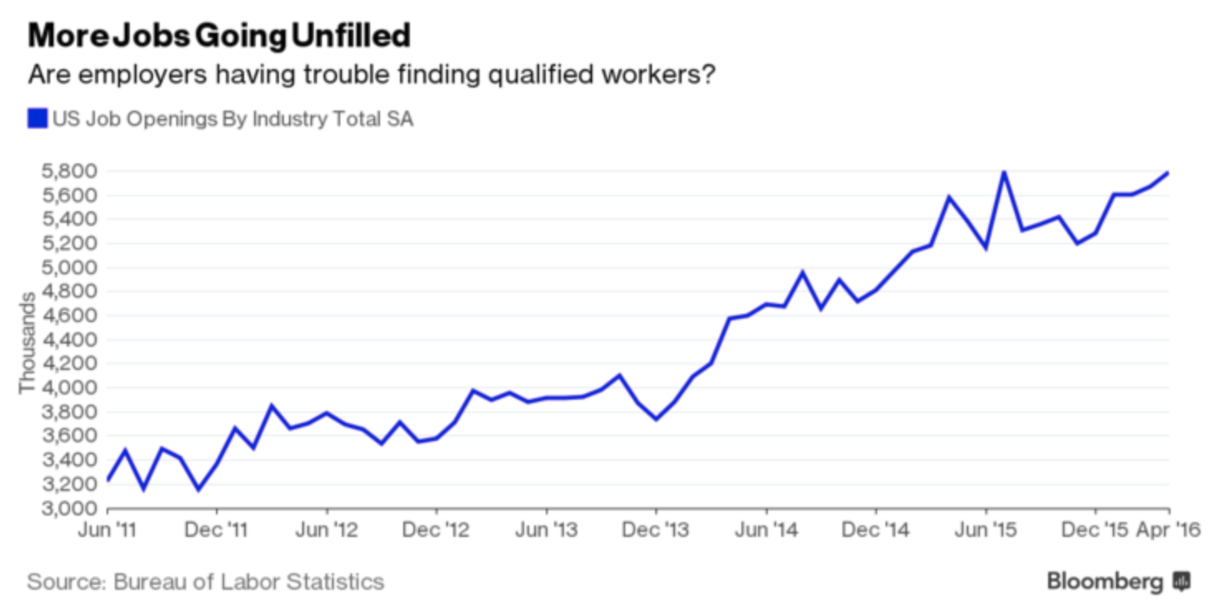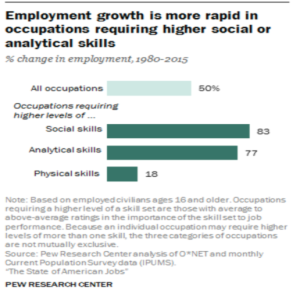A Changing Focus in Education
by
We are changemakers. We are learners. We are educators.
A changing focus in education
American education is in the midst of a major transformation, driven in large part, by a technology-focused global economy. Societal shifts like the Industrial Revolution had great impacts on education in the past. We can now ask ourselves, how is the digital revolution affecting the jobs and opportunities that await America’s students?

This graphic from a June 2016 Bloomberg.com article shows the growing trend in the US where companies are having more and more trouble finding qualified skilled workers. But what skills are employers seeking? According to an October Pew Research Center report, economic change is reshaping the workplace, and requiring an emphasis on social and analytical skills.

Teachers inspire others to follow their passion AND empower them with the skills they need to do so. In our digital age, social, communication, and analytical/problem solving skills are essential skills for careers. These skills require a change in emphasis in the classroom. These changes were summarized by former NAIS (National Association of Independent Schools) President Patrick Bassett as the six big shifts in education (2013).
- From knowing to doing;
- From teacher-centered to student centered;
- From the individual to the team;
- From the consumption of information to the construction of meaning;
- From schools to networks (online peers and experts); and
- From single sourcing to crowd- sourcing.
These shifts are exemplified in the Next Generation Science Standards (NGSS) and the newly adopted state standards throughout our nation that are grounded in the vision of A Framework for K-12 Science Education (NRC, 2011). These standards are the basis for the vision for a high quality-education for every student in the US that prepares them for the next step of their choosing because they support students in developing the communication, analytical, and problem solving skills necessary for job opportunities in the Digital Age. In addition, these standards are based on the current research in neuroscience and education that show us the most effective ways that students learn.
As a teacher, I can have confidence in using the standards as guides for navigating these shifts in education in the 21st Century. Real change, however, goes beyond what we believe and say –to what we do. How can we be changemakers and encourage the “rethink” of education that is imperative for economic opportunity in the Digital Age? We give students the opportunity to experience a classroom focused on the “big shifts” listed above. Classrooms that exemplify these shifts are student-centered. They are characterized by teams of students utilizing peer and expert networks, collaborating to construct understanding and design solutions, and tapping into the collective intelligence and feedback potential of other classrooms.
.
The ART of Video Framework can serve as a path to prepare for students for today’s world
The ART of Video framework leverages technology and video, standards, and a peer-to-peer classroom network to provide multiple opportunities for students to learn in new ways, and attain the skills needed for success in a globally-connected world and information-based economy. The ART framework also provides teachers access to a system for providing students with relevant real-life contexts and opportunities to develop and use 21st Century Skills. These skills: critical thinking, creative thinking, collaboration, and communication; are the abilities that students need to develop to support success in a globally connected world and information-based economy.
While using ART, students develop and use critical thinking skills to gather and analyze data, construct claims supported by evidence, and communicate reasoning using ART video products. Through the connected classrooms network, students use digital media to collaborate and publish with peers as well as to provide coaching feedback to peer groups outside of the classroom. ART can help teachers be the change-makers to shift to the kinds of teaching and learning needed to empower students in this digital age.
Start transforming your classroom. Take the first step by learning more about the ART of video framework by clicking the large button below. ART can navigate the path to new opportunities for you and your students, and will support the kinds of day-to-day changes in classroom instruction that exemplify the shifts needed to provide opportunity for all students in this globally connected digital world.
.
More Resources
Find out more about A K-12 Framework for Science Education, and find more research about science education at the National Academies Press
Find out more about the Next Generation Science Standards, and read more about why science education needs an update at this infograph.
References
Bassett, P. F. (2013, July 1). Schools of the Future: The Big Shifts. Retrieved from http://www.nais.org/Articles/Pages/Schools-of-the-Future-The-Big-Shifts.aspx
Coy, P. (2016, June 8). Has America Run Out of Workers to Fill its Open Jobs? Retrieved from https://www.bloomberg.com/news/articles/2016-06-08/has-america-run-out-of-workers-to-fill-its-open-jobs
Pew Research Center. (2016, October 6). The State of American Jobs. Retrieved from http://www.pewsocialtrends.org/2016/10/06/the-state-of-american-jobs/
National Research Council (NRC). 2012. A framework for K-12 science education: Practices, crosscutting concepts, and core ideas. Washington DC: National Academies Press
NGSS Lead States. 2013. Next Generation Science Standards: For States, by states. Washington, DC: National Academies Press.
.g
With over 22 years of classroom experience, Tricia Shelton is driven by a passion to help students develop critical and creative thinking skills. Tricia is a 2014 NSTA Distinguished Teaching Award winner for her contributions to and demonstrated excellence in Science Teaching. She serves as the Director of Education Research at BenchFly and can be found on Twitter @benchfly_art and @TdiShelton.

